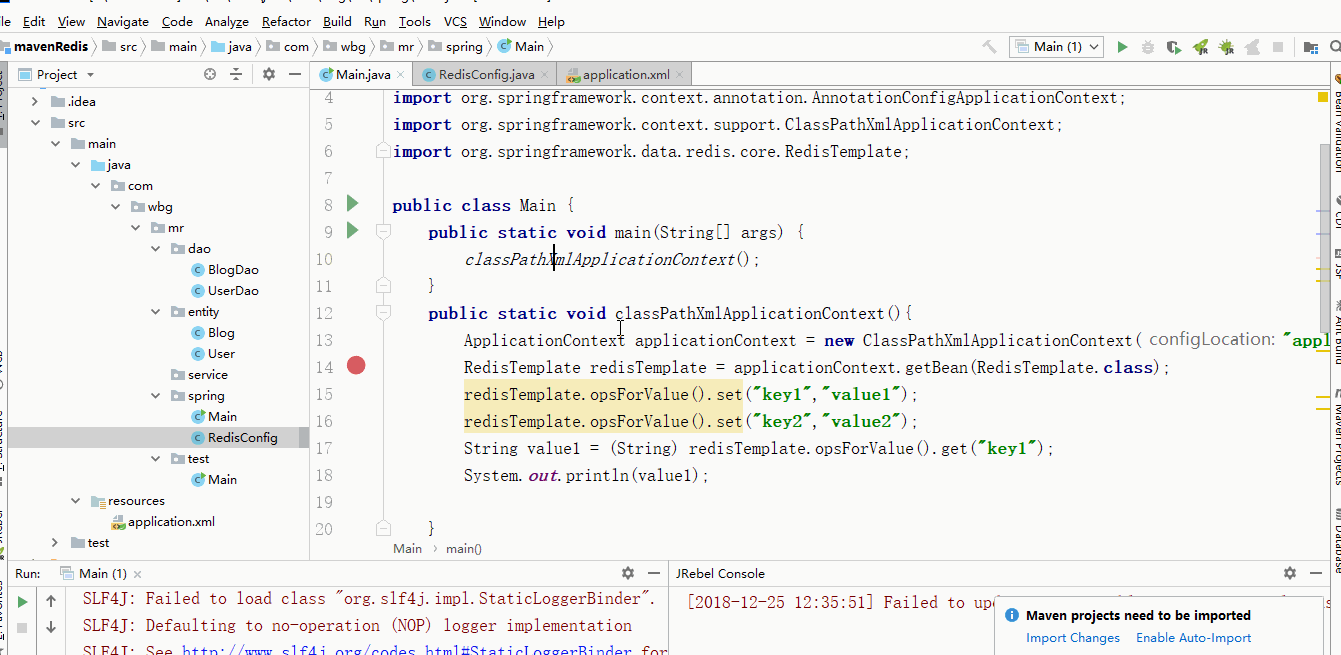spring配置redis(xml+java方式)(最底层)
条件:引用好架包
<dependency> <groupId>org.springframework.data</groupId> <artifactId>spring-data-redis</artifactId> <version>2.1.3.RELEASE</version> </dependency> <dependency> <groupId>redis.clients</groupId> <artifactId>jedis</artifactId> <version>2.9.0</version> </dependency>
一、使用xml进行配置
1、xml进行配置JedisPoolConfig、JedisConnectionFactory、Spring RedisTemplate-
<?xml version="1.0" encoding="UTF-8"?> <beans xmlns="http://www.springframework.org/schema/beans" xmlns:xsi="http://www.w3.org/2001/XMLSchema-instance" xsi:schemaLocation="http://www.springframework.org/schema/beans http://www.springframework.org/schema/beans/spring-beans.xsd"> <!-- 配置JedisPoolConfig--> <bean id="poolConfig" class="redis.clients.jedis.JedisPoolConfig"> <property name="maxIdle" value="50"/> <property name="maxTotal" value="100"/> <property name="maxWaitMillis" value="20000"/> </bean> <!--配置JedisConnectionFactory--> <bean id="connectionFactory" class="org.springframework.data.redis.connection.jedis.JedisConnectionFactory"> <property name="hostName" value="localhost"/> <property name="port" value="6379"/> <property name="poolConfig" ref="poolConfig"/> </bean> <!--使用字符串进行序列化--> <bean id="stringReadisSerializer" class="org.springframework.data.redis.serializer.StringRedisSerializer"/> <!--使用JDK的序列化器进行转化--> <bean id="jdkSerializationRedisSerializer" class="org.springframework.data.redis.serializer.JdkSerializationRedisSerializer"/> <!--配置Spring RedisTemplate--> <bean id="redisTemplate" class="org.springframework.data.redis.core.RedisTemplate"> <property name="connectionFactory" ref="connectionFactory"/> <property name="keySerializer" ref="stringReadisSerializer"/> <property name="valueSerializer" ref="stringReadisSerializer"/> </bean> </beans>
2、使用:
ApplicationContext applicationContext = new ClassPathXmlApplicationContext("application.xml");
RedisTemplate redisTemplate = applicationContext.getBean(RedisTemplate.class);
redisTemplate.opsForValue().set("key1","value1");
redisTemplate.opsForValue().set("key2","value2");
String value1 = (String) redisTemplate.opsForValue().get("key1");
System.out.println(value1);
二、使用java方式
1、创建RedisConfg配置类
package com.wbg.mr.spring; import org.springframework.context.annotation.Bean; import org.springframework.context.annotation.Configuration; import org.springframework.data.redis.connection.jedis.JedisConnectionFactory; import org.springframework.data.redis.core.RedisTemplate; import org.springframework.data.redis.serializer.StringRedisSerializer; @Configuration public class RedisConfig { @Bean public JedisConnectionFactory jedisConnectionFactory(){ JedisConnectionFactory jcf = new JedisConnectionFactory(); jcf.setHostName("localhost"); return jcf; } @Bean public RedisTemplate redisTemplate(){ RedisTemplate rt = new RedisTemplate(); rt.setConnectionFactory(jedisConnectionFactory()); rt.setKeySerializer(new StringRedisSerializer()); rt.setValueSerializer(new StringRedisSerializer()); return rt; } }
2、使用
ApplicationContext applicationContext = new AnnotationConfigApplicationContext(RedisConfig.class); RedisConfig redisConfig = applicationContext.getBean(RedisConfig.class); RedisTemplate redisTemplate = redisConfig.redisTemplate(); redisTemplate.opsForValue().set("key11","value11"); redisTemplate.opsForValue().set("key12","value12"); String value11 = (String) redisTemplate.opsForValue().get("key11"); System.out.println(value11);
测试:

package com.wbg.mr.spring; import org.springframework.context.ApplicationContext; import org.springframework.context.annotation.AnnotationConfigApplicationContext; import org.springframework.context.support.ClassPathXmlApplicationContext; import org.springframework.data.redis.core.RedisTemplate; public class Main { public static void main(String[] args) { annotationConfigApplicationContext(); } public static void classPathXmlApplicationContext(){ ApplicationContext applicationContext = new ClassPathXmlApplicationContext("application.xml"); RedisTemplate redisTemplate = applicationContext.getBean(RedisTemplate.class); redisTemplate.opsForValue().set("key1","value1"); redisTemplate.opsForValue().set("key2","value2"); String value1 = (String) redisTemplate.opsForValue().get("key1"); System.out.println(value1); } public static void annotationConfigApplicationContext(){ ApplicationContext applicationContext = new AnnotationConfigApplicationContext(RedisConfig.class); RedisConfig redisConfig = applicationContext.getBean(RedisConfig.class); RedisTemplate redisTemplate = redisConfig.redisTemplate(); redisTemplate.opsForValue().set("key11","value11"); redisTemplate.opsForValue().set("key12","value12"); String value11 = (String) redisTemplate.opsForValue().get("key11"); System.out.println(value11); } }






